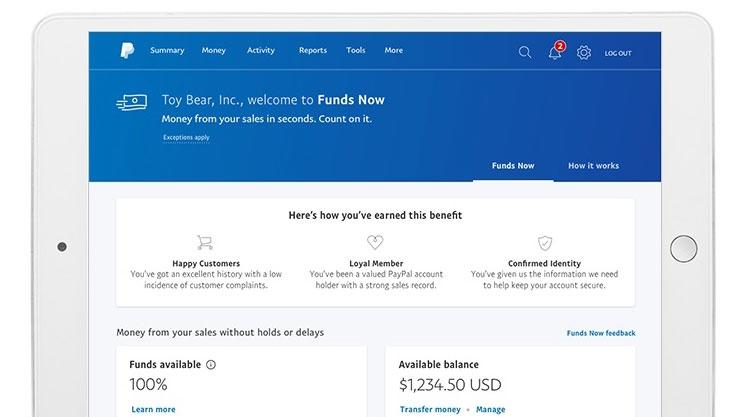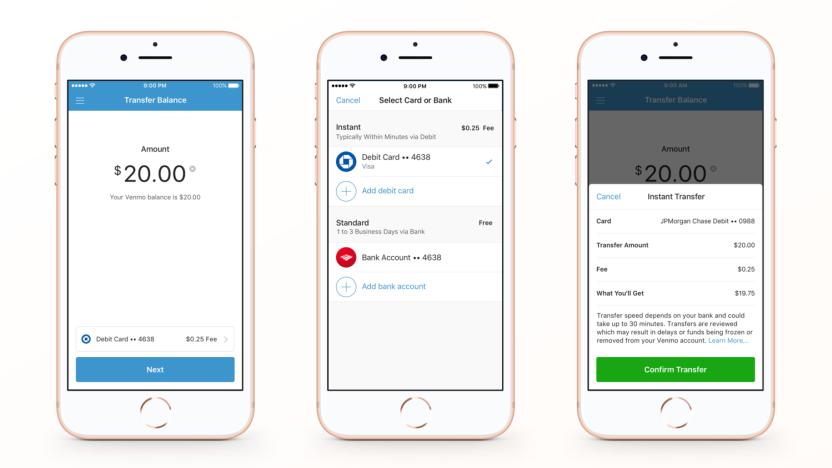funds
Latest

Puerto Rico's government lost $2.6 million to a phishing scam
An email phishing scam duped the government of Puerto Rico into transferring more than $2.6 million into a fraudulent account, The Associated Press reports. A government agency transferred the funds on January 17th, but the incident was just discovered this week. Puerto Rico is working with the FBI to investigate and recover the funds.

PayPal will instantly pay businesses after they make a sale
PayPal is adding a new feature for businesses that use its platform for their sales. Funds Now will let certain businesses in good standing -- that means without fraud concerns or an excess of customer complaints -- get instant access to funds from completed sales, even if there's an ongoing dispute. The company says that one of the biggest complaints from small businesses has been delays in accessing funds, which are sometimes upwards of 21 days long. Funds Now eliminates that wait by getting rid of any holds, delays and reserves on that cash.

Venmo's 25-cent instant transfers are now available for everyone
Payment sharing services from Paypal, Square and Venmo are great, but it can take some time to move funds from those accounts to your bank so you can use them in real life. Last year, Paypal introduced $0.25 instant transfer fees to make it much faster to move money to your real-life bank. Now Paypal-owned Venmo is doing the same, offering transfers of funds in less than 30 minutes.

White House pledges $400 million for 5G research
Following yesterday's FCC vote to adopt new rules to guide the development of 5G technology, the Obama Administration is pledging support for research. More specifically, the White House announced a $400 million Advanced Wireless Research Initiative that will be led by the National Science Foundation (NSF). The project aims to build four "city-scale testing platforms" over the next 10 years. In the announcement, the administration reiterated that the US is the first to free up spectrum above 24 GHz for the high-speed networks that are said to be 100 times faster than the 4G we use today.

PayPal makes it even easier to call in your debts
While PayPal has made its name (and serious money) helping people pay for their online and in-store purchases, sending cash to friends or family takes a little bit longer than it needs to. That's why the company created the Venmo app, but that's only available to US users. Even though Venmo, Facebook Messenger, Square Cash and other peer-to-peer payment apps are gaining in popularity, many people still shy away from actually asking for the money they're owed. In an attempt to take the friction out of asking for and receiving payments, the e-commerce giant has launched PayPal.me, a new service that makes requesting money as simple as sending someone a web link. Not only that, it's a link that'll never change.

Send money to your friends with Facebook Messenger
Using Facebook Messenger to chat amongst your pals? Well, now you can employ that same app to send funds, too. After hints dropped last fall, the social network announced its tool that sends money inside Messenger would roll out in the US in the months to come. To send a few bucks to someone who grabbed lunch when your forgot your debit card, just hit the appropriately-labeled "$" icon, enter the amount and hit pay. The currency is transferred immediately, but it'll take a couple of days to show up in the recipient's bank account -- similar to a regular ol' deposit.
.png.cf.jpg)
Child's Play closes year with record-breaking $7.6 million
An incredible holiday drive propelled Child's Play's annual fundraising to $7.6 million, a new record for the charity organization by more than $2 million. Considering that annual figure was at $2.5 million as recently as November, it's a remarkable achievement by Child's Play and its backers alike. "Child life specialists reach out to us every year, overwhelmed and amazed at the generosity of gamers," wrote Jamie Dillon on the Child's Play site. "The iPads they use help distract and comfort kids as they prep for surgery. An Xbox will find its way to the community playroom for siblings to play together again. The movies, craft supplies, CDs, toys, and books sent from Amazon wishlists let kids just be kids for a moment: not sick kids, not hurt kids, not scared or lonely kids. Just kids playing like kids. And it's all thanks to you." As ever, the money was raised by a variety of activities, from gaming marathons and charity streams to bake sales and auctions; Desert Bus alone contributed an impressive $520,000 towards this year's funds. The $7.6 million raised in 2013 takes Child's Play's total across a decade to over $25 million, with all that money going to improving kids' lives in 90 hospitals worldwide. If that doesn't warm your heart at the turn of the year, nowt in 2014 will.

The Daily Grind: Do you hoard in-game money?
I will never be a rich man in real life. My only interest in money is in spending it, generally on whatever game is offering the cutest in-game hats at any given moment. In games, however, I am absolutely loaded. I carefully conserve my money, spending only when absolutely necessary, and by the time I reach the level cap, I'm already fairly well-off. My bankroll in Final Fantasy XIV is enormous, my wallet overflows with credits in Star Wars: The Old Republic, and if I ever go back to World of Warcraft, it will involve enough gold to swim in, Scrooge McDuck-style. There's rarely a reason to hoard cash, of course. It doesn't convey any advantages aside from allowing you to make enormous impulse purchases. In many games, it's not going to help you really kit out your character, and you don't need to be flush with cash to cover mandatory expenses like travel and repairs. But sometimes it's just nice to know that even if you're subsisting on a diet of instant noodles and water, your character is part of the one percent. So do you hoard in-game money? Every morning, the Massively bloggers probe the minds of their readers with deep, thought-provoking questions about that most serious of topics: massively online gaming. We crave your opinions, so grab your caffeinated beverage of choice and chime in on today's Daily Grind!

Kickstarter pledges more transparency, publishes project stats page with daily updates
Every time we boot up a browser there appears to be a new iPad mount or Arduino project on Kickstarter, but just how many projects have there been to date? How many were successful? And how much might that microfunding startup be netting in commission cash? You can find all those answers through a new Kickstarter stats page (and some number crunching on a calculator), updated daily with key raw data that's tallied, and broken up by category as well. To date, 60,786 projects have launched, of which 24,986 (44 percent) were successfully funded, 31,722 failed and 4,078 are currently active on the site. Of the $261 million that's come in, $219 million has been in the form of "successful dollars," representing $10.95 million in income for the company itself based on a five-percent commission rate -- roughly the same amount raised for Pebble, a single project. Speaking of million-dollar-plus projects, there have been a total of seven, including one in the Music category, three in Games, two in Design and one in Comics (Pebble falls within the Design category, not Technology). There are plenty more stats to comb through if you've been hankering for a peek behind the scenes at Kickstarter -- it's all at our source link after the break.

Insert Coin: Deeper Smart sonar Fishfinder for Android and iOS
In Insert Coin, we look at an exciting new tech project that requires funding before it can hit production. If you'd like to pitch a project, please send us a tip with "Insert Coin" as the subject line. We can't say a smartphone-connected sonar fish detector ranks high on our must-have list, but man is it a cool idea. Friday Lab's taking the plunge with its Deeper Smart Fishfinder -- a spherical waterproof device that beams back individual fish depth and location info, along with temperature and floor depth to your Android 2.2+ or iOS 4.0+ smartphone or tablet within 150 feet via Bluetooth. You simply use a standard rod and line to lower Deeper from a bridge, boat or shore, and the device automatically powers on when it makes contact with water -- a six-hour battery should suffice for all but the most dedicated of fishermen, unless they have a USB power source nearby for charging. Naturally, the sphere is water- and shock-resistant, and can operate in temperatures ranging from -10 to 40 degrees Celsius (14 to 104 degrees Fahrenheit). The Deeper app also provides air temperature and moon phase readouts, and social media functionality that lets you post fishing updates to Facebook or Twitter -- so all of your less fortunate friends can see how much fun you're having catching fish and stuff. The first 60 Deeper backers can snag one set for $129 (plus $20 shipping) on Indiegogo, while latecomers can hop on board for $20 more. You can also place your pre-order through the company's site, also for $149. There's just shy of four weeks left for Friday Lab to meet its $49,000 goal, so hit up our source link after the break to show your support. And if you're not quite ready to commit, there's a video awaiting you there as well.

Insert Coin: Knut WiFi-enabled sensor hub (video)
In Insert Coin, we look at an exciting new tech project that requires funding before it can hit production. If you'd like to pitch a project, please send us a tip with "Insert Coin" as the subject line. On the surface, Knut (pronounced Kah-noot) doesn't sound terribly exciting -- it's a pocketable WiFi-enabled device that beams you realtime stats over the web. But consider the possible applications, and you'll be much more anxious to pick one up. You can use Knut to measure humidity in your humidor, the temperature in your fish tank or even the status of a door or window. You can monitor stats in realtime, or set alerts so you'll know something's wrong before your goldfish cooks in the tank, those precious Cuban cigars you smuggled through Customs dry up and crumble or someone sneaks into your house through a window after you check in miles away on Foursquare. After popping in a pair of AAA batteries (which are said to last from 2 weeks to 10 years, depending on the battery and syncing options), you assign Knut an email address, which it then uses to communicate. Other Knuts can use the same email address, from which they'll send updates at pre-set intervals. Knut ships with built-in temperature and battery level sensors, and it's compatible with a variety of add-ons, from humidity and vibration to door and water presence sensors. You can also create your own sensor using the breakout board. The project creators have developed a functional prototype, but they need to raise additional funds to pay programmers and buy materials for mass production. As usual, that's where you come in. The first 200 Kickstarter backers can hop on board the pre-order train with a pledge of $80, while an unlimited number of devices will be available for $95. A $115 pledge will get you a Knut and an additional sensor, while $175 will up the order to one Knut, three sensors and a three-port hub. There's six weeks left to go on the campaign, with a goal of $25,000 and an estimated September ship date. As always, you'll find everything you need in the demo video and source link, just after the break.

Insert Coin: Playsurface open-source multitouch computing table
In Insert Coin, we look at an exciting new tech project that requires funding before it can hit production. If you'd like to pitch a project, please send us a tip with "Insert Coin" as the subject line. A Microsoft Surface in every office? Yeah, fat chance. At $8,000, you may never see Samsung's SUR40 glow in the wild, but budget versions of the backlit HD table have begun popping up, such as the Merel Mtouch, which retails for half the price. Still, four grand is a lot to ask from casual users -- we need a bargain-basement option to help catapult the concept to success. The Playsurface could be one solution, with an open-source design and a much more affordable price tag. The multitouch computing table is the product of Templeman Automation, and its creators have begun promoting their concept on Kickstarter. In its current iteration, the Playsurface will ship in two flavors -- short, to double as a coffee table, and tall for stand-up applications -- with a $1,750 pledge netting backers a complete kit. Setting out to fulfill the goal of widespread adaptation, the creator is promising one Playsurface kit with a $1,750 pledge, including a Windows computer, a short-throw 1280 x 800-pixel DLP projector and a transparent touch surface, all housed within a self-assembled wood enclosure. There's also an infrared LED strip to aid with input recognition and something called a "Blob Board," which serves as a dedicated hardware processor tasked with touch detection and connects to the computer via USB. A $350 pledge gets you a Blob Board alone, while $650 is matched with a table (sans computer and projector) and $1,250 will net you a full kit, less the computer. There's just shy of four weeks left to go to get your Playsurface pledge in -- hit up the source link to make it happen.

FCC to dole out up to $300 million to help carriers expand service in rural areas
It seems like almost every day that we receive a press release announcing Verizon or AT&T is planning to expand its LTE coverage to three, five, eleven new markets. But in some remote pockets of the country, you'd be lucky to latch onto even a solid 3G signal. In a bid to make sure those folks in the boonies get their due, the Federal Communications Commission is establishing a fund to encourage carriers to roll out 3G and 4G service in sparser areas. All told, the agency plans to award up to $300 million to mobile operators, with funds going to the providers offering the lowest rates. The winners will be decided in a sealed, single-round auction, which opens June 27th and is set to close July 11th. As a condition for receiving the funds, carriers must agree to cover at least 75 percent of the road miles within a given census tract. While it's unclear at this early stage which mobile players will take the bait, the FCC's already signaled which parts of the country will be first in line for upgraded service -- namely, Rocky Mountain states like Utah and Idaho, along with Maine, Appalachia and upstate New York.

Visualized: Google charts the rise and fall of United States revenues
Where would we be without Google? Well, we wouldn't have pretty charts to gawk at, for starters! The Mountain View squad has pulled 10 years' worth of fiscal data from the US Census Bureau and compiled it into some gorgeous, infinitely sortable, and re-organizable graphs. They inspire both our admiration and apprehension, as their lines illustrate most starkly the shrinkage that replaced US economic growth over the latter half of the last decade. We've only picked out a few of the big states here, but all 50 are in Google's public database -- why not hit the source link and check up on your local governors' pecuniary (mis)management skills, eh?

EU sets aside €6.4b for research and innovation grants
For all its foibles, the European Union does fancy itself as quite the progressive supranational body and you need look no further than its gigantic €50.5 billion (to be spent between 2007 and 2013) R&D stimulus program for evidence. Over the next 14 months, the Euro bureau will distribute €6.4 billion to universities, SMEs (small and medium enterprises) and other research organizations that seek to pursue its stated goals. Those include tackling the problems of climate change, the Union's greying population, food and energy source security and sustainability, as well as more generic health and quality of life challenges. The primary goal is stated as "translating research into new technologies, products and services" -- in other words, less vaporware -- though we imagine the biggest justifier for this sizable injection de dinero will be the 165,000 new jobs that it's expected to create. Full PR after the break.

The Daily Grind: Hey big spender!
Gil. Gold. Adeena. ISK. Influence. Infamy. Chips. Crowns. Whatever the game calls it (and there are a lot more words aside from those) money is an important part of most MMOs. Much like money in the real world, it generally follows three simple rules: you need it, you don't have enough of it, and you can't get it fast enough. And we all deal with it in our own way. But when the time comes, almost every one of us will pony up seemingly astronomical sums for that one thing. It might be a mount, maybe weapons or armor, perhaps a piece of furniture in a game with player housing. Whatever the item is, the cost of obtaining it becomes a non-obstacle, and your cash display turns into a new experience bar that you need to fill for your precious treasure. So, what was your biggest purchase? Was it something that was once expensive but now cheap, or is it still pricey as ever? Were you happy to have it or regretful at blowing your bankroll? And perhaps most importantly, do you still have it and use it, or has it long since been replaced?

Tracking the Keynote Index Fund
Matt Haughey has worked up a little analysis/thought experiment of just how much money could be made by buying stocks before every Macworld Keynote of the past ten years-- he calls it the Keynote Index Fund, and has the stock prices before every keynote, directly after every 'note, and a day after every 'note.And the fact is that buying the stock a day before and holding it for 48 hours (until the day after) would have made you money over the past ten years-- he calculates 1.2% growth over 24-hour period, and 2.2% growth over a 48 hour period. Of course, that doesn't hold a candle to what you would have earned if you just kept Apple stock the whole time (holding on to $10,000 of Apple stock since 1997 would have you holding shares worth $525,187 today).But the fact is that Macworld keynotes can make wily stock traders money. The worst performing keynote so far was in 2005, when only the Mac mini and the shuffle were announced, and the best was last year, when the iPhone was first introduced. So just standard common sense just tells you that if the iUltraportable does appear, you could probably make money with a little day trading*, but if it doesn't show up (and there are no other major announcements), you could take the worst bath so far on the Keynote Index Fund.*This advice is given by a nonprofessional and should not be listened to under any circumstances or by anyone-- past performance of a stock means nothing to future performance. Plus, I'm still hungover from New Year's Eve, and in no condition to give stock tips anyway.[Via Waxy]








